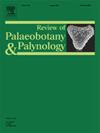The role of agroforestry yards in the diet of Melipona (Melikerria) interrupta Latreille, 1811 (Hymenoptera, Apidae) in a terra-firme environment near the confluence of the Amazon and Tapajós Rivers
IF 1.7
3区 地球科学
Q2 PALEONTOLOGY
引用次数: 0
Abstract
This study aimed to identify the botanical origin of Melipona interrupta honey produced in agroforestry backyards (AB) by traditional communities near the confluences of the Amazon and Tapajós Rivers. For comparison purposes, stingless beehives were installed in a secondary forest (SF) environment as well. In all, forty-four honey samples were analyzed from four meliponaries in two areas (AB1 and AB2; SF1 and SF2) between July 2021 and June 2022 in Arapixuna. In AB1, 25 pollen types were found in the honey samples and, in AB2, 22 were found. More than 50% of the pollen types found in the honey samples in the ABs were related to plants present only in the SF, indicating that the bees left the ABs and collected pollen in the SF. The main resources collected by M. interrupta for honey composition were Protium heptaphyllum present in 70% of the samples, followed by Triplaris type (68%), Psidium guajava (52%), Bellucia imperialis and Eugenia biflora (38%) and Tapirira guianensis (34%). The survey of botanical species in the ABs indicated that most plant species were fruit trees; however, the bees visited a low percentage of these plants. When analyzing the SF samples, a behavioral pattern of foraging was observed which was similar to those of the ABs. These data indicate that the two environments studied have melliferous characteristics that favor beekeeping. Moreover, ABs also have advantageous characteristics in relation to the SF, such as improved protection of colonies against invaders/theft of honey and the ease of maintenance of the colonies.
在亚马逊河和Tapajós河汇合处的陆地环境中,农林业工场对Melipona (Melikerria) interrupta Latreille, 1811(膜翅目,蜂科)食性的作用
本研究旨在确定亚马逊河和Tapajós河汇合处附近传统社区农林业后院(AB)生产的Melipona interrupta蜂蜜的植物来源。为了比较,在次生林(SF)环境中也安装了无刺蜂箱。在2021年7月至2022年6月期间,总共分析了Arapixuna两个地区(AB1和AB2; SF1和SF2)四个蜜源的44份蜂蜜样本。AB1中有25种花粉类型,AB2中有22种花粉类型。在ABs中发现的蜂蜜样品中超过50%的花粉类型与仅存在于SF中的植物相关,表明蜜蜂离开ABs并在SF中收集花粉。对蜂蜜成分采集的主要资源为七叶Protium(70%),其次为Triplaris(68%)、Psidium guajava(52%)、Bellucia imperialis和Eugenia biflora(38%)和Tapirira guianensis(34%)。植物种类调查表明,植物种类以果树为主;然而,蜜蜂造访这些植物的比例很低。结果表明,这两种环境均具有有利于养蜂的蜜蜂特征。此外,ABs还具有相对于SF有利的特性,例如更好地保护蜂群免受入侵者/盗窃蜂蜜和易于维护蜂群。
本文章由计算机程序翻译,如有差异,请以英文原文为准。
求助全文
约1分钟内获得全文
求助全文
来源期刊
CiteScore
3.50
自引率
21.10%
发文量
149
审稿时长
6 months
期刊介绍:
The Review of Palaeobotany and Palynology is an international journal for articles in all fields of palaeobotany and palynology dealing with all groups, ranging from marine palynomorphs to higher land plants. Original contributions and comprehensive review papers should appeal to an international audience. Typical topics include but are not restricted to systematics, evolution, palaeobiology, palaeoecology, biostratigraphy, biochronology, palaeoclimatology, paleogeography, taphonomy, palaeoenvironmental reconstructions, vegetation history, and practical applications of palaeobotany and palynology, e.g. in coal and petroleum geology and archaeology. The journal especially encourages the publication of articles in which palaeobotany and palynology are applied for solving fundamental geological and biological problems as well as innovative and interdisciplinary approaches.

 求助内容:
求助内容: 应助结果提醒方式:
应助结果提醒方式:


